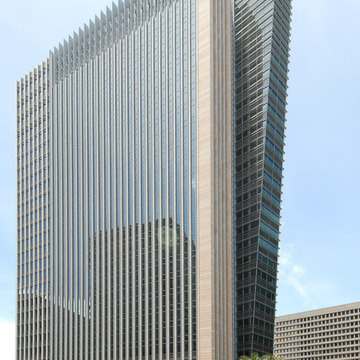Formally powerful and elegantly assured, First Hawaiian Center interprets the Islands within the context of Kohn Pedersen Fox's architectural vocabulary. The thirty-story building, the tallest in Hawaii at 438 feet, follows William Pedersen's penchant to compose elements in unorthodox relationships which visually fragment a high-rise's mass. In this building, two interlocking triangles were employed, with a predominantly beige Clandore limestone mauka elevation and a blue glass makai side. Like other Kohn Pedersen Fox compositions, the building's ground level aims for a pedestrian-friendly relationship with the street. Such detailing as the entrance pergola and the Bishop Street side's fins draw on Art Deco themes employed with contemporary élan, while the three-story, prismatic art-glass wall by Thomas Carpenter of New York refracts a rainbow of light into the banking hall.
Beyond the rainbow wall and the mauka-makai color differentiation, other Hawaiian themes enliven the building's forms. The Bishop Street end of the makai element tapers downward, intended to recall a ship's prow and Hawaii's maritime past. Cantilevered over the street, this “prow” dazzles occupants within with precipitous views of the sidewalk below. The high-rise tower is sufficiently set back from the street to allow 43 percent of its lot to be open space. The twenty-four-thousand-square-foot plaza, with its water, art, and flora, was designed by Hawaii landscape architect Juli Kimura Walters, who drew upon the use of stone slabs at Keio Plaza in Tokyo for her inspiration.
The New York City–based architectural firm of Kohn Pedersen Fox was founded in 1976 and established an international reputation for high-rise design, notably 333 Wacker Drive (1983) in Chicago and the Shanghai World Financial Center (2008). Walters, Kimura, Motoda, one of the oldest landscape architecture firms practicing in Hawaii today, was started by George Walters in the mid-1950s. Born in Hawaii, Walters studied landscape architecture at the University of California at Berkeley. In 1965, Juli Kimura joined the firm and she and Walters wed in 1969. Upon George Walters's death in 1976, she took over the firm. In the mid-1980s, Michael Motoda was made a partner.






















